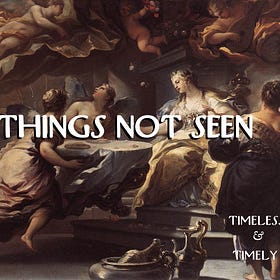Everything Communicates
And I mean *everything*

“The world is for thousands a freak show; the images flicker past and vanish; the impressions remain flat and unconnected in the soul. Thus they are easily led by the opinions of others, are content to let their impressions be shuffled and rearranged and evaluated differently.” — Johann Wolfgang von Goethe, 1776
We’re surrounded by symbols.
There are the obvious — logos, brand marks, — and there are the more subtle, such as behaviors, speeches, and the absence of something. You’ll recall the related recent essay on Things Not Seen.
Things Not Seen
“What is essential is invisible to the eye.” — Antoine de Saint-Exupéry, 1943 We’re surrounded by the invisible every day — things both wondrous and terrifying, sometimes simultaneously. Consider all of the things that we can’t see: atoms, air, viruses, tim…
I’ll get back to voids in a moment, but first, a look at how we’ve come to accept and use symbolism as part of how we communicate.
From the earliest days, humans have used imagery to convey meaning. Tens of thousands of years ago, our ancestors painted pictures on walls of caves: the oldest has been dated to 64,000 years ago, as created by Neanderthals in Maltravieso cave in Cáceres, Spain.
Such images were designed to mark accomplishments, warn of danger, or provide a guide to hunters. They were utilitarian as well as decorative.
As we move through recorded history, we find other examples of symbols being used for broader messages. For example, the story of Noah and the flood ends with God making a promise:
And God said, “This is the sign of the covenant I am making between me and you and every living creature with you, a covenant for all generations to come: I have set my rainbow in the clouds, and it will be the sign of the covenant between me and the earth. (Genesis 9:12-13)
This is something that can be passed on to future generations, as they look at the sky and wonder over a rainbow. It’s a powerful reminder of this promise from times past.
Similarly, the story of Moses and the Ten Commandments: consider how powerful it is to have life’s guidelines written down on two tablets. You don't need an entire volume of text; even in ancient times, the virality of listicles proved effective.
Keep reading with a 7-day free trial
Subscribe to Timeless & Timely to keep reading this post and get 7 days of free access to the full post archives.



